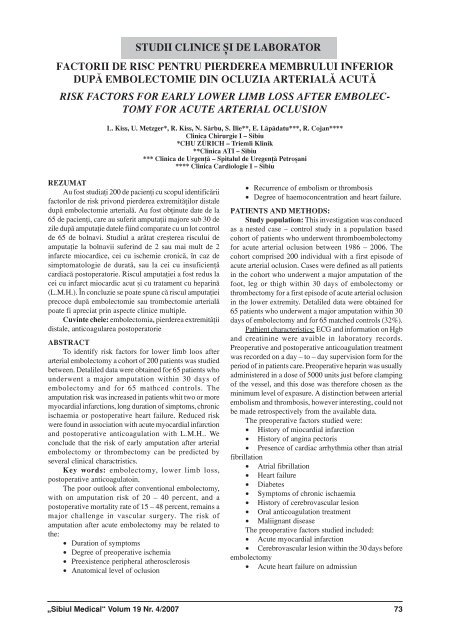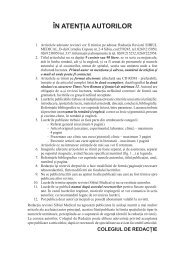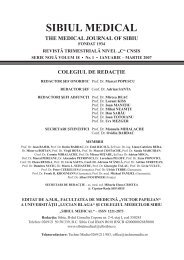You also want an ePaper? Increase the reach of your titles
YUMPU automatically turns print PDFs into web optimized ePapers that Google loves.
STUDII CLINICE ÇI DE LABORATOR<br />
FACTORII DE RISC PENTRU PIERDEREA MEMBRULUI INFERIOR<br />
DUPÅ EMBOLECTOMIE DIN OCLUZIA ARTERIALÅ ACUTÅ<br />
RISK FACTORS FOR EARLY LOWER LIMB LOSS AFTER EMBOLEC-<br />
TOMY FOR ACUTE ARTERIAL OCLUSION<br />
L. Kiss, U. Metzger*, R. Kiss, N. Sârbu, S. Ilie**, E. Låpådatu***, R. Cojan****<br />
Clinica Chirurgie I – Sibiu<br />
*CHU ZÜRICH – Triemli Klinik<br />
**Clinica ATI – Sibiu<br />
*** Clinica de UrgenÆå – Spitalul de UregenÆå Petroçani<br />
**** Clinica Cardiologie I – Sibiu<br />
REZUMAT<br />
Au fost studiaÆi 200 de pacienÆi cu scopul identificårii<br />
factorilor de risk privond pierderea extremitåÆilor distale<br />
dupå embolectomie arterialå. Au fost obÆinute date de la<br />
65 de pacienÆi, care au suferit amputaÆii majore sub 30 de<br />
zile dupå amputaÆie datele fiind comparate cu un lot control<br />
de 65 de bolnavi. Studiul a aråtat creçterea riscului de<br />
amputaÆie la bolnavii suferind de 2 sau mai mult de 2<br />
infarcte miocardice, cei cu ischemie cronicå, în caz de<br />
simptomatologie de duratå, sau la cei cu insuficienÆå<br />
cardiacå postoperatorie. Riscul amputaÆiei a fost redus la<br />
cei cu infarct miocardic acut çi cu tratament cu heparinå<br />
(L.M.H.). În concluzie se poate spune cå riscul amputaÆiei<br />
precoce dupå embolectomie sau trombectomie arterialå<br />
poate fi apreciat prin aspecte clinice multiple.<br />
Cuvinte cheie: embolectomia, pierderea extremitåÆii<br />
distale, anticoagularea postoperatorie<br />
ABSTRACT<br />
To identify risk factors for lower limb loos after<br />
arterial embolectomy a cohort of 200 patients was studied<br />
between. Detaliled data were obtained for 65 patients who<br />
underwent a major amputation within 30 days of<br />
embolectomy and for 65 mathced controls. The<br />
amputation risk was increased in patients whit two or more<br />
myocardial infarctions, long duration of simptoms, chronic<br />
ischaemia or postoperative heart failure. Reduced risk<br />
were found in association with acute myocardial infarction<br />
and postoperative anticoagulation with L.M.H.. We<br />
conclude that the risk of early amputation after arterial<br />
embolectomy or thrombectomy can be predicted by<br />
several clinical charactristics.<br />
Key words: embolectomy, lower limb loss,<br />
postoperative anticoagulatoin.<br />
The poor outlook after conventional embolectomy,<br />
with on amputation risk of 20 – 40 percent, and a<br />
postoperative mortality rate of 15 – 48 percent, remains a<br />
major challenge in vascular surgery. The risk of<br />
amputation after acute embolectomy may be related to<br />
the:<br />
• Duration of symptoms<br />
• Degree of preoperative ischemia<br />
• Preexistence peripheral atherosclerosis<br />
• Anatomical level of oclusion<br />
• Recurrence of embolism or thrombosis<br />
• Degree of haemoconcentration and heart failure.<br />
PATIENTS AND METHODS:<br />
Study population: This investigation was conduced<br />
as a nested case – control study in a population based<br />
cohort of patients who underwent thromboembolectomy<br />
for acute arterial oclusion between 1986 – 2006. The<br />
cohort comprised 200 individual with a first episode of<br />
acute arterial oclusion. Cases were defined as all patients<br />
in the cohort who underwent a major amputation of the<br />
foot, leg or thigh within 30 days of embolectomy or<br />
thrombectomy for a first episode of acute arterial oclusion<br />
in the lower extremity. Detaliled data were obtained for<br />
65 patients who underwent a major amputation within 30<br />
days of embolectomy and for 65 matched controls (32%).<br />
Pathient characteristics: ECG and information on Hgb<br />
and creatinine were avaible in laboratory records.<br />
Preoperative and postoperative anticoagulation treatment<br />
was recorded on a day – to – day supervision form for the<br />
period of in patients care. Preoperative heparin was usually<br />
administered in a dose of 5000 units just before clamping<br />
of the vessel, and this dose was therefore chosen as the<br />
minimum level of expasure. A distinction between arterial<br />
embolism and thrombosis, however interesting, could not<br />
be made retrospectively from the available data.<br />
The preoperative factors studied were:<br />
• History of miocardial infarction<br />
• History of angina pectoris<br />
• Presence of cardiac arrhythmia other than atrial<br />
fibrillation<br />
• Atrial fibrillation<br />
• Heart failure<br />
• Diabetes<br />
• Symptoms of chronic ischaemia<br />
• History of cerebrovascular lesion<br />
• Oral anticoagulation treatment<br />
• Maliignant disease<br />
The preoperative factors studied included:<br />
• Acute myocardial infarction<br />
• Cerebrovascular lesion within the 30 days before<br />
embolectomy<br />
• Acute heart failure on admissiun<br />
„<strong>Sibiul</strong> <strong>Medical</strong>“ Volum 19 Nr. 4/2007 73




